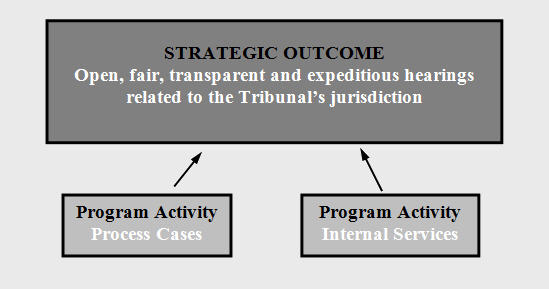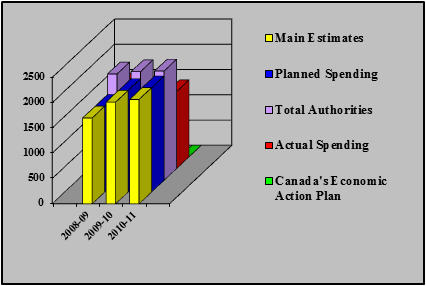Common menu bar links
Breadcrumb Trail
ARCHIVED - Registry of the Competition Tribunal - Report
 This page has been archived.
This page has been archived.
Archived Content
Information identified as archived on the Web is for reference, research or recordkeeping purposes. It has not been altered or updated after the date of archiving. Web pages that are archived on the Web are not subject to the Government of Canada Web Standards. As per the Communications Policy of the Government of Canada, you can request alternate formats on the "Contact Us" page.
Minister's Message
![The Honourable [Type Minister’s name]](images/Minister%20Christian%20Paradis.jpg)
Last year, Industry Canada and its Portfolio partners played a key role in advancing the government's agenda in Year 2 of Canada's Economic Action Plan.
Specific stimulus measures taken by the Industry Portfolio under Canada's Economic Action Plan were aimed at boosting economic development, supporting small and medium sized enterprises, improving Canada's research and development capacity and strengthening communities. The Portfolio's stimulus measures targeted communities through the Marquee Tourism Events Program and Broadband Canada: Connecting Rural Canadians program. Further investments in the Industrial Research and Assistance Program, the Industrial Research and Development Internship program, the Canada Graduate Scholarships Program and the Knowledge Infrastructure Program expanded Canada's research and development capacity. Investing in the Canadian space industry maintained Canadian expertise and leadership in space robotics. Through these and other stimulus initiatives, we helped create jobs, build communities and nurture the roots of economic recovery.
In 2010-11, the Competition Tribunal continued in its judicial role of hearing cases dealing with matters related to the Competition Act such as mergers, misleading advertising and restrictive trade practices. As in previous years, the Tribunal acted on matters involving potential effects on competition. The outcomes of the Competition Tribunal's cases influence both merchants and Canadian consumers.
Cultivating an environment for job creation, growth and competitiveness, both domestically and internationally, remains a priority for Industry Portfolio. We will work to improve cost-effectiveness and efficiency and will contribute to the Government of Canada's priority to balancing the budget and achieving real results for all Canadians.
It is my pleasure to present the Registry of the Competition Tribunal's Departmental Performance Report for 2010-11.
The Honourable Christian Paradis
Minister of Industry and Minister of State (Agriculture)
Section I: Departmental Overview
Raison d’�tre
The Competition Tribunal is a quasi-judicial tribunal whose sole purpose and raison d'�tre is to hear and decide all applications related to civil reviewable matters set out in the Competition Act: deceptive marketing practices (Part VII.1) and restrictive trade practices (Part VIII). The purpose of this legislation is to maintain and encourage competition in Canada and to provide a fair and secure marketplace for Canadians. The Tribunal operates at arm's length from government and its departments. The Competition Tribunal Act that establishes the Tribunal also provides for the Registry of the Competition Tribunal, an administrative infrastructure to support the proper conduct of the business of the Tribunal.
Responsibilities
The Registry of the Competition Tribunal is designated a department under the Financial Administration Act. It supports all aspects of the Tribunal's work and ensures the Tribunal can hold hearings anywhere in Canada, as necessary. Registry headquarters are located in the National Capital Region. Parties to Tribunal cases file applications and documents with the Registry, which also issues documents and orders for all cases brought before the Tribunal. This Departmental Performance Report pertains to the activities of the Registry in support of the Tribunal and its deliberations, and not to Tribunal cases themselves.
Since its creation in 1986, the Tribunal has heard cases relating to mergers, abuse of dominant position, deceptive marketing and various trade practices that have involved key players in several industries. Cases have involved a number of business areas, including pharmacies; furniture stores; importers of cast iron pipes; airline computer reservation systems; oil refining and gasoline retailing; community newspapers; aspartame; waste disposal; car parts; marketing research services; green handling services; weight-loss products; fuel-saving devices; fireplace maintenance products; banking services; poultry supply; and career management services.
Strategic Outcome(s) and Program Activity Architecture (PAA)
- Process Cases
- Internal Services

Process Cases
The Registry of the Competition Tribunal's main program activity is to process cases by providing the public with efficient access to case documents and decisions, as well as with efficient hearing support services.
The Tribunal hears cases and the Registry manages the material for the cases heard by the Tribunal under Part VII.1 (deceptive marketing practices) and Part VIII (restrictive trade practices) of the Competition Act.
Internal Services
Internal Services is an umbrella term for activities under the Registry's administration that meet program needs and other corporate obligations. These activities are: management and oversight services; communications services; legal services; human resources management services; financial management services; information management services; information technology services; real property services; material services; acquisition services; and travel and other administrative services.
Organizational Priorities
Performance/Priority Status Legend
Mostly met: 80 to 99 per cent of the expected level of performance (as evidenced by the indicator and target or planned activities and expected outputs) for the expected result or priority identified in the corresponding RPP was achieved during the fiscal year.
| Priority | Type | Strategic Outcome(s) and/or Program Activity(ies) |
|---|---|---|
| In-depth training for Tribunal members | New | Open, fair, transparent and expeditious hearings related to the Tribunal's jurisdiction. |
| Status | ||
|
||
| Priority | Type | Strategic Outcome(s) and/or Program Activity(ies) |
|---|---|---|
| Increase electronic hearing of cases | New | Open, fair, transparent and expeditious hearings related to the Tribunal's jurisdiction. |
| Status | ||
|
||
| Priority | Type | Strategic Outcome(s) and/or Program Activity(ies) |
|---|---|---|
| Develop partnerships with other small agencies to provide registry staff more in depth experience in case processing | Ongoing | Open, fair, transparent and expeditious hearings related to the Tribunal's jurisdiction. |
| Status | ||
|
||
Risk Analysis
The Registry of the Competition Tribunal has a major planning challenge in that the Tribunal can only react to external demands. Its sole function is hearing references and applications and issuing orders. The number of applications brought before the Tribunal depends on the enforcement policy adopted by the Commissioner of Competition and the number of applications filed by individuals or companies under the private access provisions of the Act.
The demand for services from the Registry has remained relatively stable even with the increase in the Tribunal's jurisdiction which includes the introduction of a new civil provision to address price dual-track approach to deal with agreements between competitors. Training members on this expanded jurisdiction was key in ensuring their readiness to hearing those types of cases.
An increase in the volume of work is still expected due to the new jurisdiction therefore more emphasis was placed on the enhancement of our electronic filing system in anticipation of the introduction of a directive to the parties to proceed electronically with all cases. The parties will benefit from shorter hearings resulting from maximizing the use of hearing room technologies.
Registry staff turnover has been minimal during the fiscal year. The Registry continued to provide training to some employees identified as back-ups to key positions to ensure they have the knowledge and abilities required to fulfill additional responsibilities if and when required. A partnership that had been established with the Registry of the Public Servants Disclosure Protection Tribunal was extended and two additional agreements were developed with other organizations, one with Health Canada and the other with the Courts Administration Services. These agreements maximized the use of resources and provided developmental opportunities to staff in an effort to retain them in key positions.
Summary of Performance
2010-11 Financial Resources ($ thousands)
| Planned Spending | Total Authorities | Actual Spending |
|---|---|---|
| $2,066 | $2,164 | $1,526 |
2010-11 Human Resources (FTEs)
| Planned | Actual | Difference |
|---|---|---|
| 14 FTEs | 8.9 FTEs | 5.1 FTEs |
| Performance Indicators | Targets | 2010-11 Performance |
|---|---|---|
| Client level of satisfaction regarding quality of service | 80% or more clients are satisfied with service received from the Registry | Met all - Our measure of client satisfaction is usually based on feedback obtained from parties to cases heard by the Tribunal. In 2010-11 a few hearings which related to the continuation of a case from previous year took place. Informal feedback received from parties after case management conferences on other cases was all very positive. No negative feedback was received through the website. |
| Tribunal members' level of satisfaction regarding quality of service | 80% or more of Tribunal members are satisfied with service received from the Registry | Met all - The Tribunal members' level of satisfaction reached 90% in 2010-11. Their feedback was obtained on the quality of services provided by the Registry throughout a hearing life cycle, on organization of the members' continuous learning program, and to a lesser extent, on various ad hoc services provided to them. |
| Program Activity | 2009-10 Actual Spending ($ millions) |
2010-11 ($ thousands) | Alignment to Government of Canada Outcomes | |||
|---|---|---|---|---|---|---|
| Main Estimates |
Planned Spending |
Total Authorities |
Actual Spending |
|||
| Process Cases | $882 | $1,549 | $1,550 | $1,648 | $838 | This program activity links to the Economic Affairs sector of activity of the Government of Canada, particularly the outcome area of a fair and secure marketplace. |
| Total | $882 | $1,549 | $1,550 | $1,648 | $838 | |
| Program Activity | 2009-10 Actual Spending ($ millions) |
2010-11 ($ thousands) | |||
|---|---|---|---|---|---|
| Main Estimates |
Planned Spending |
Total Authorities |
Actual Spending |
||
| Internal Services | $486 | $517 | $516 | $516 | $688 |
The variance between the planned versus utilized financial and human resources was created by the lower than expected number of cases filed at the Tribunal. The Registry can only react to the number of applications brought before the Tribunal by the Competition Bureau or by individuals and companies under the private access provisions of the Act. A few large cases were filed in 2010-11 but their actual hearings have been scheduled for 2011-12 and 2012-13. This results in a deferral of expenses and not necessarily a savings because significant expenses will be incurred when these larger cases are going to be heard by the Tribunal.
The variance in Internal Services stems from expenses incurred to finalize our enhancements to the electronic filing system and to complete the implementation of the mandatory new security standards to our Information Technology infrastructure.
Expenditure Profile
Canada's Economic Action Plan (CEAP)
In view of the mandate of the Competition Tribunal, the Registry was not involved in the delivery of initiatives that were part of Canada's Economic Action Plan.
Departmental Spending Trend
($ thousands)

The lower than expected utilization of financial resources in 2010-11 resulted from the change in jurisdiction of the Tribunal that became effective in March 2010. There is usually a lag between the time a new legislation is implemented and the impact it has on the work of the Tribunal. The impact of the new jurisdiction should be felt in 2011-12 and future years.
Estimates by Vote
For information on our organizational votes and/or statutory expenditures, please see the 2010–11 Public Accounts of Canada (Volume II) publication.
